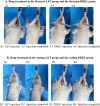Effect of Wnt10a/β-catenin signaling pathway on promoting the repair of different types of dentin-pulp injury
- PMID: 37700204
- PMCID: PMC10520212
- DOI: 10.1007/s11626-023-00785-z
Effect of Wnt10a/β-catenin signaling pathway on promoting the repair of different types of dentin-pulp injury
Abstract
How to repair dentin-pulp injury effectively has always been a clinical problem, and the comparative study of repair process between different injuries is unknown. Dental pulp stem cells (DPSCs) often are selected as seed cells for the study of dentin-pulp injury repair due to excellent advantages in odontogenesis and pulp differentiation. Although many previous researches have indicated that the Wnt protein and Wnt/β-catenin signaling pathway were crucial for dental growth, development, and injury repair, the specific mechanism remained unknown. In this study, different dentine-pulp injury models of adult mice were established successfully by abrasion and cutting methods. The gross morphology and micro-CT were used to observe the repair of injured mice incisor in different groups. We found that the repair time of each group was different. The repair time of the cutting group was longer than the abrasion group and the qRT-PCR detection showed that the expression of DSPP in the cutting group was higher than that in the abrasion group, but there was no significant difference in proliferation among the groups. In vivo and cell experiments showed that activation of Wnt/β-catenin signaling pathway can promote the proliferation and odontoblast differentiation of DPSCs. In addition, by using RNAscope staining, we observed that Wnt10a was mainly expressed in the proliferative region and partially expressed in the odontoblast region. The Western blotting results showed that in the early stage of repair, the expression of Wnt10a increased with the extension of days after injury in both abrasion and cutting group and the increase of Wnt10a was tested obviously on the 5th day after injury. But on the 7th day after injury, the expression of Wnt10a was still obvious in the cutting group, while the expression of Wnt10a was significantly reduced in the abrasion group, which was close to the control group. It is suggested that Wnt10a acts as a repair-related protein and has an important role in tooth injury repair. Wnt10a was activated by R-spondin and LiCl, and Wnt10a-siRNA DPSCs were constructed to inhibit Wnt10a. The results showed that Wnt10a/β-catenin signaling pathway promoted the proliferation and odontoblast differentiation of DPSCs. It plays a crucial role in the repair process of different injuries. This study enriched the mechanisms of Wnt10a /β-catenin signaling pathways in different types of dentin-pulp injury repair, which could provide experimental evidences for the target gene screening and also give some new ideas for the subsequent research on the molecular mechanisms of tooth regeneration.
Keywords: DPSCs; Dentin-pulp complex injury; Wnt10a/β-catenin signaling pathway.
© 2023. The Author(s).
Conflict of interest statement
The authors declare no competing interests.
Figures











References
-
- About I. Dentin-pulp regeneration: the primordial role of the microenvironment and its modification by traumatic injuries and bioactive materials. Endo Top. 2013;28:61–89. doi: 10.1111/etp.12038. - DOI
MeSH terms
Substances
Grants and funding
- 202101AY070001-188/Kunming Medical University Applied Basic Research Joint Special Fund of Science and Technology Department of Yunnan Province
- 82260184/National Natural Science Foundation of China
- 2020J0212/Scientific Research Fund Project of Education Department of Yunnan Province
- 202105AE160004/Science and Technology Innovation Team Project of Yunnan Province
- CXTD202213/The technology innovation team of multi-stage and multi-disciplinary joint prevention and treatment of malocclusion ,Kunming Medical University
LinkOut - more resources
Full Text Sources
Miscellaneous

